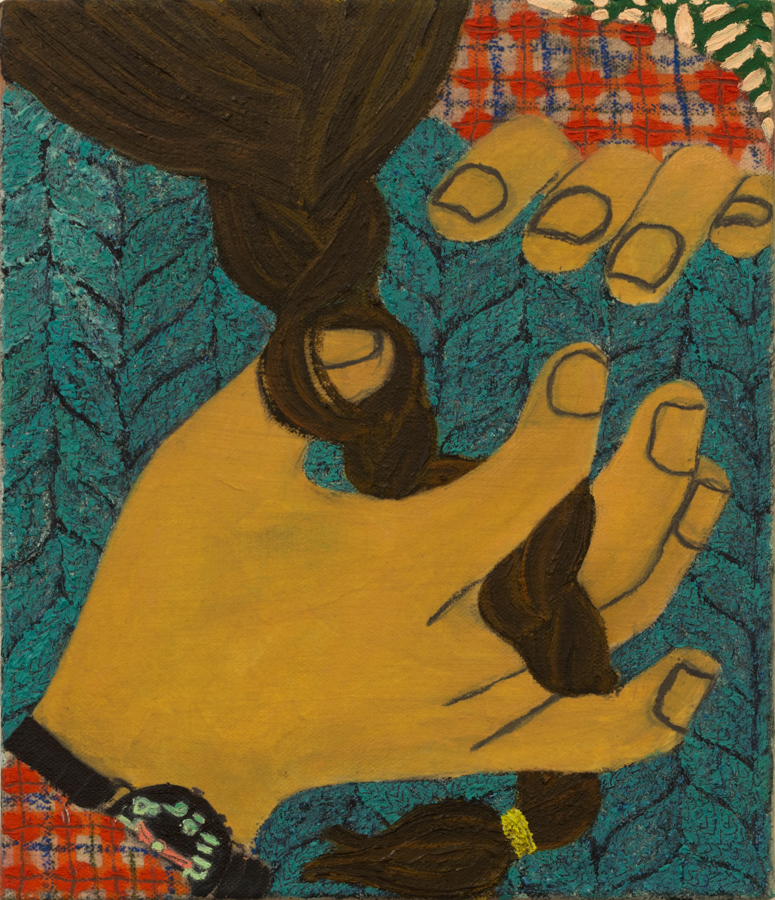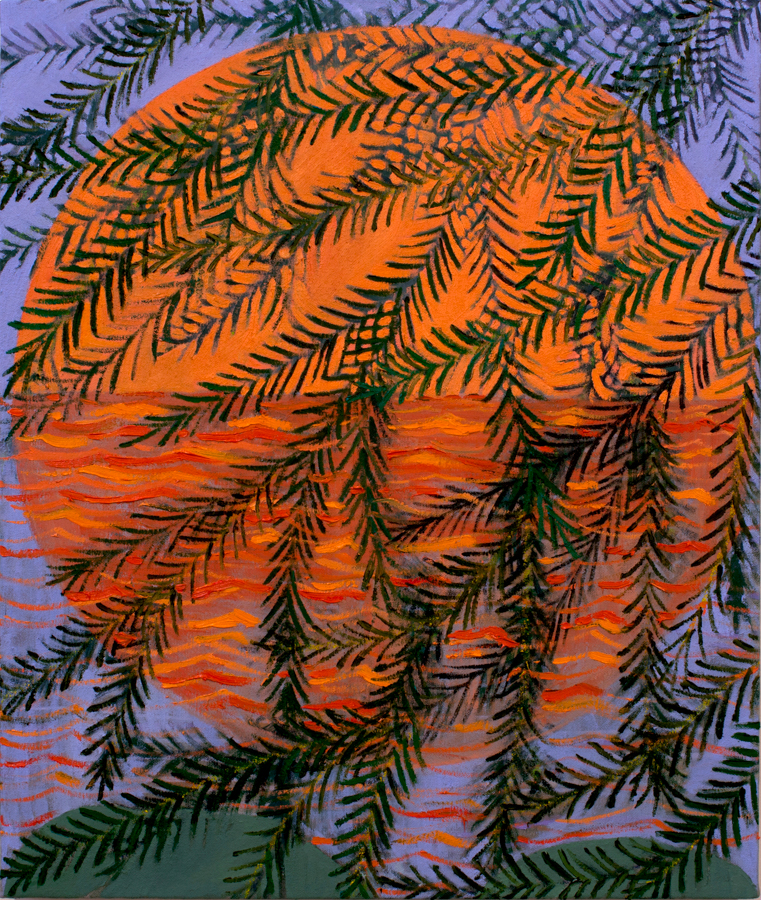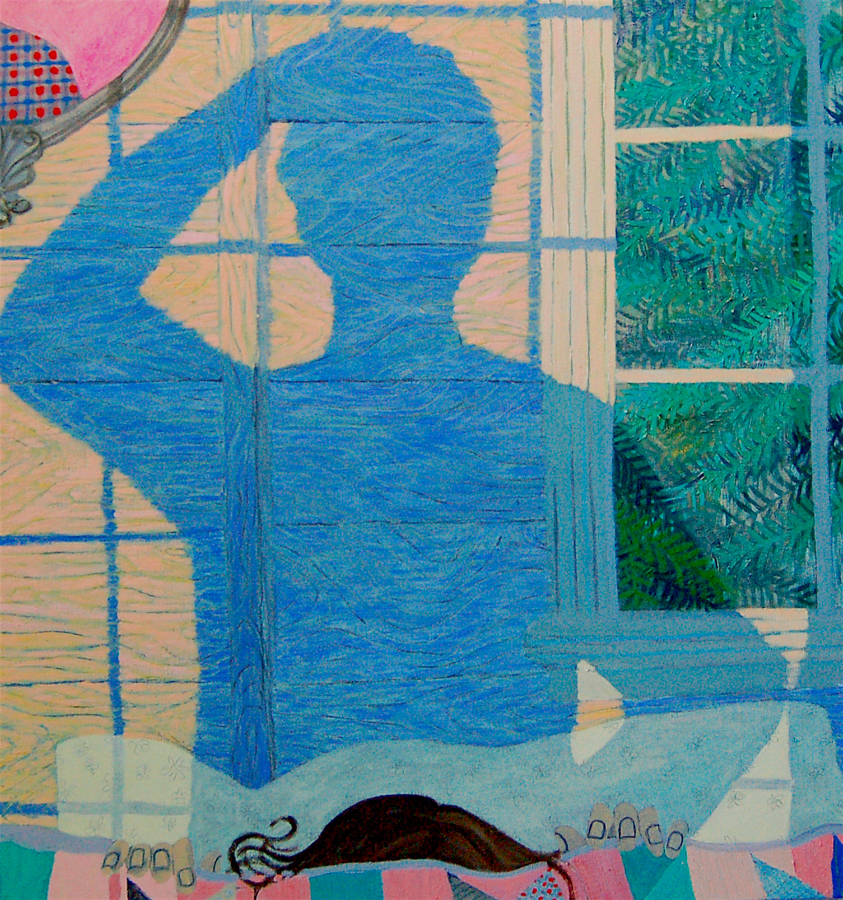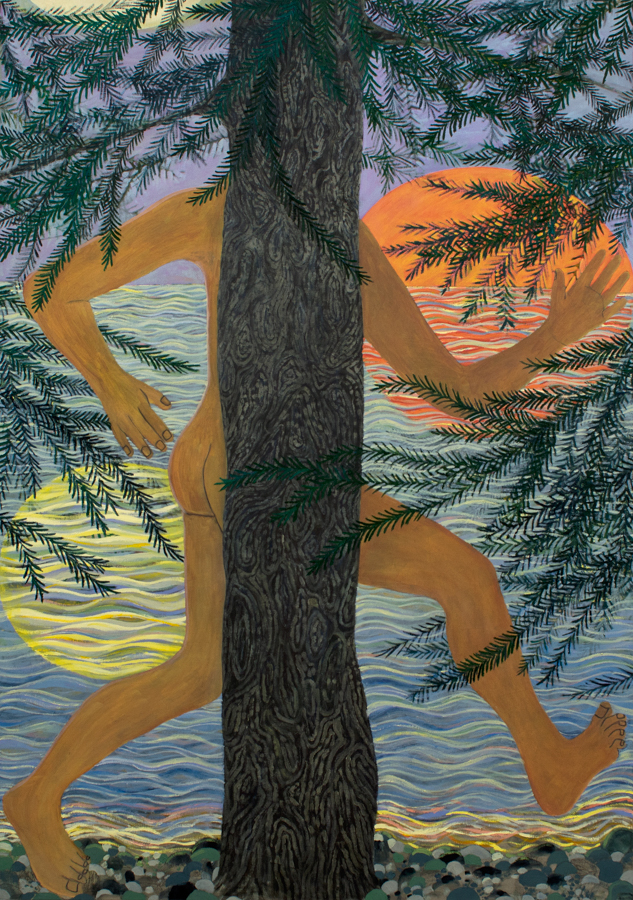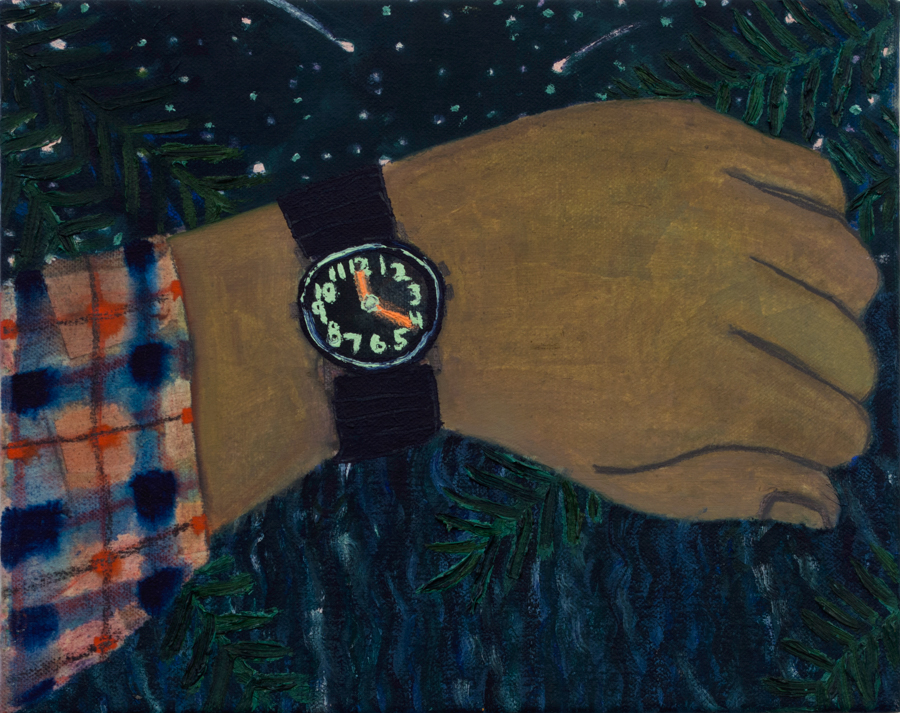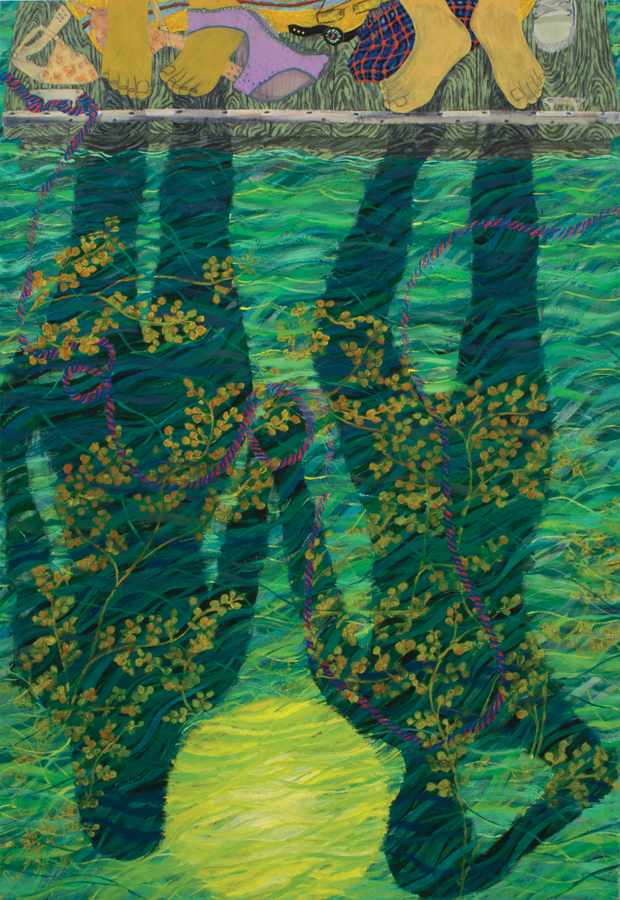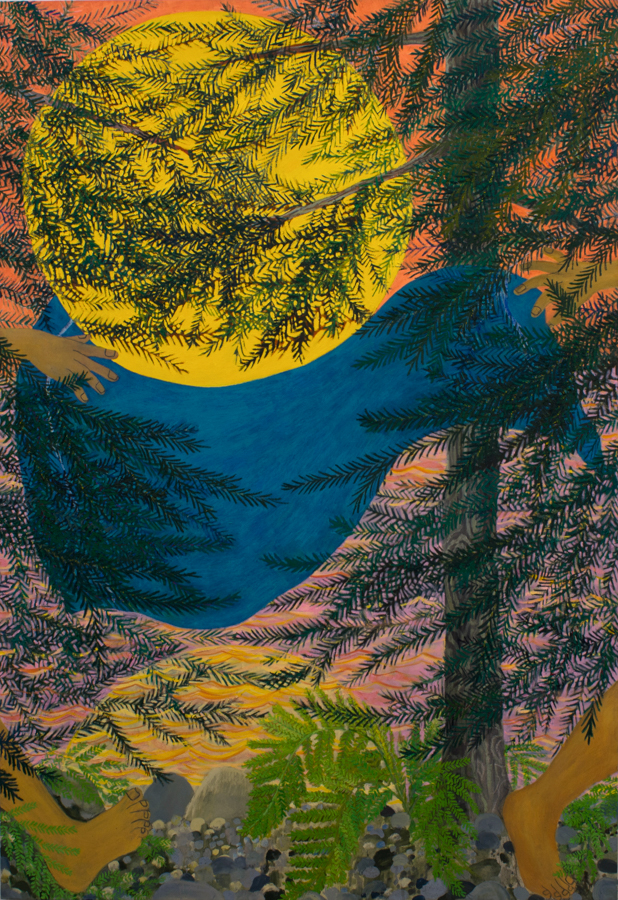Giordanne Salley
Giordanne Salley was born in 1986 in Dayton, Ohio. She received her BFA from Anderson University in 2009 and her MFA from Boston University in 2013. Recently Giordanne’s work has been included in shows at James Cohan Gallery in NYC, David and Schweitzer Contemporary in Brooklyn, NY, Monya Rowe Gallery in St. Augustine, FL, and Steven Harvey Fine Art Projects in NYC. Her work has been featured in New American Paintings issue #104, the Boston Globe, and the New York Times. She is represented by Steven Harvey Fine Art Projects in New York, NY and lives and works in Brooklyn, NY.
STATEMENT
These paintings are about being in love and how that feels when I think about it later, alone in the studio. Recently I have been painting figures in nature. I am thinking of objects in nature such as rocks, water, branches or a big fat sun/moon- as part of the narrative in these paintings and acting as metaphor for human interaction and strength of feeling. These paintings are a mix of memory and imagination. The imagined landscape is greatly influenced by time spent in the woods of Maine and Vermont, as well as time spent daydreaming about those places while living and working in New York City. All of my recent paintings together represent a nonlinear narrative about two people experiencing love and the passing of time in the woods.
Giordanne's Brooklyn studio
Q&A with Giordanne Salley
Questions by Emily Burns
Hi Giordanne! Can you give us some insight into your process? Do you plan your compositions beforehand? Does drawing play a role?
Hi, sure I would be happy to. A lot of drawing goes into making my work, but not necessarily a lot of planning. I spend a lot of time making small ink drawings in a sketchbook to get ideas. The drawings are usually quick and awkward. I will have thoughts about things like fingers stuck in braids and rocks watching sunsets, and then I will make a crude little drawing, then a few more drawings until I feel like I have a complete idea. Not all of my drawings become paintings. When I am ready to size up, I staple a bunch of raw canvas to my studio wall and mark out a rough perimeter for the size of the painting, then I make the drawing again, but larger, life size. The drawing on the canvas is just as crude. I have always struggled with sizing up from a small drawing, so it has helped me to do most of the drawing on the surface of the canvas. I also use collage as a tool to help me solidify my forms and composition before painting. At some point, I prime the drawing/collage with clear gesso. The gesso drags some of the drawing material across the canvas and makes these unpredictable neutral tones that create a nice ground, and then I begin the painting
Do most of your drawings function as preparatory sketches?
Almost all of my drawings function as preparatory sketches. Most of my small drawings are in bound sketchbooks and then the rest are under the surface of the paintings. I do occasionally show drawings or works on paper, but usually only when the exhibition specifically requires drawings.
The pine needle seems to be an important element in your paintings. Can you tell us a bit more about the significance?
The landscapes in my paintings are a sort of invented/imagined/remembered combination of places that hold personal significance, specifically water and woods in Maine and Vermont. I spent some formative time living in Vermont and spend time in Maine each summer. The lush, quiet, green landscape in both of those places has really seeped into my work. The pine branches and needles act as characters in my paintings as much as the figures do. Formally, they function as screens between the figure and the viewer or as arms that hold the figure in the painting, but I also think they play a narrative role. The branches reach out for each other like hands. At times, they gently hold the figures and act as a welcoming presence.They conceal and reveal parts of the action, encouraging the viewer to consider their role.
The figures in your paintings often seem hidden in some way, whether they are cropped out of the composition, appear as a silhouette, are covered by branches, or only their hands or feet are visible.
Even though I think of the figures in my paintings as specific people, I think that by obscuring their faces, their identity is a little more open. The viewer’s place in the painting is also open to interpretation. I remember looking at Poussin’s painting Adam and Eve in Paradise and imagining what my role as a viewer of that painting could possibly be. Of course in the story of Adam and Eve, there are no other people inhabiting the earth yet, so as a viewer my role is sort of ambiguous and open, but not participatory unless I think of myself as one of the figures in the painting or as some omniscient presence. While my figures do not live in “Eden,” I think seeing that painting gave me permission to keep the viewer at a distance and allow them to either invite themselves in all the way as part of the painting or choose to be a voyeur. I am still working through these ideas and am not entirely sure why some things keep happening in the work. I will usually draw/ paint the entire figure, then slowly over the course of the painting decide what to conceal and what to reveal.
The figures are often in the act of undressing, can you talk about the prevalence of that action?
I have many fond memories of group swims and skinny dipping. I think there is a certain freedom in being so vulnerable around other people and in nature. Being in love with someone is kind of like that, like being naked all the time. Sometimes it is great and sometimes it is weird, but then there you are really, truly knowing one another. The figures in these paintings are completely uninhibited.
Additionally, camping, swimming, and the outdoors are narratives that you explore often. The works seems to reference these themes as memories—what about these activities interests you most?
My newest paintings are specifically responding to summers spent in Vinalhaven, Maine being very much aware of subtle shifts in time, light, and weather. My boyfriend and I return to the same place each year where we do not have cell reception or internet access. Without all of the usual daily distractions and pressures, you so quickly become aware of basic needs and desires. My paintings are about that. I remember last year watching the sun go down on a hazy evening. The haze turned the whole sky this lavender blue color and the sun was a huge hot pink/orange ball. Because of the haze, you could see the complete circle of the sun and look directly at it as it sank down. I remember having this feeling of fullness and elation watching that happen. The feeling was similar to being in love. I love living in New York, but I think I spend the whole year in my studio daydreaming about that feeling of watching the hot sun sink down. Nature has always been part of my work, but I did not really begin painting about the woods until I moved away from them. I think there is a sense of longing that is perhaps the source of my imagery.
Can you elaborate on what it's like to work from personal experience and why you do?
My work is very personal. I would not know how to make a painting that wasn’t. I have always felt that the more personal and specific an artwork is, the more universal it can be. It is sort of like the idea of being naked together.
You often work in oil and paper on canvas, and the surfaced of the paintings are richly varied. Can you describe how this surface is structured?
I mentioned earlier how most of my drawing is actually buried under the layers of paint and collage and separated from the oil paint by clear gesso. I draw on raw canvas with dry materials, sometimes also collaging onto the canvas, then gesso over the drawing before painting. Sometimes parts of the underdrawing/ collage remain visible in the finished painting leaving a little window into the history of the process. I have found that this way of making a painting is the best way for me to stay engaged in the surface from beginning to end.
What is a typical day like for you?
On a typical studio day, I will arrive at the studio, change into my studio clothes, find something good to listen to on the radio, draw for 20–30 minutes, then jump into whichever painting I feel like working on that day. If I have a lot of energy, I will start something new or work on a collage. This is a very messy, but very active and exciting part of making a painting. I usually have about 7–8 different things going at once in varying stages. I will work 8–10 hours, with periodic snacks, then go home for dinner. On the days that I have to work my day job, I try to go to my studio after work for a few hours to draw or paint pine needles or stretch some small canvases, etc… I save the big, sweeping tasks for full days if I can.
Do you feel like it is necessary to get into a particular headspace when in the studio? If so how do you get there?
I do think it is necessary to arrive with a sense of purpose. I try not to dawdle in my studio. I normally spend the first 20-30 minutes in my studio making inconsequential drawings of ideas in my sketchbook or if I don’t have any ideas, I will draw my foot or my plant. It is a sort of warm up routine that gets me into the mode of looking.
What are the most important, must-have components of your studio?
I need a window and a door. I go crazy if I do not know what time of day it is or what the weather is like outside, and I like the privacy of working behind a door. Other than that, I am pretty low maintenance. I need good wall space, my materials, and natural light. That is really it.
What do you listen to while you work? Is this an important part of your practice?
I listen to the radio a lot. I love 89.9’s Sunday morning Bluegrass show. I mostly listen to NPR, but I am not sure if it is doing anything good to have the news on in my studio. I also enjoy podcasts. I tend to veer toward either comedy or true crime podcasts and use them as timers in my studio. I will say to myself “in three episodes, I will have coffee.” I guess I tend to listen to more talk radio than to music. If I am feeling particularly moody, however, I will listen to Antony and the Johnsons or Cat Power. I don’t think that what I listen to is affecting my practice, but listening to something keeps me from being distracted by noises or other people talking in the hall, or by my phone, so that is definitely an important part of my practice (not being distracted).
What are some of the artists that you look at the most often or most recently?
I have always loved Pierre Bonnard, Edouard Vuillard, Fairfield Porter, Marsden Hartley, Kerry James Marshall, Milton Avery, Philip Guston, Nicole Eisenman, etc… I have been looking at Henri Rousseau’s jungle colors lately.
Has there ever been a book/essay/poem/film/etc that totally changed or influenced you? What are you reading right now?
I remember reading an essay in college called “Art is for Empathy” by Emily Vey Duke and feeling like she had perfectly articulated how I feel about art and its essential role in society which is to create empathy. I would not say that it changed me, but it validated and put words to something I already felt. From time to time, Wendell Berry will resurface on my bedside table. His writings have been a steadfast source of hope and mindfulness, especially the collection of poems in Given. Franny & Zooey was an important book to me, but its consequence is unknown. I just finished Leaving the Atocha Station by Ben Lerner. It’s a great book about a young writer in Madrid on a research fellowship who ends up writing abstract poetry. He is afraid that deep down he may be a fraud, but he doesn’t want anyone else to know so he shrouds himself in drama and invents personal tragedies in order to come across as more “authentic.” It is heartbreaking and hilarious and I could totally relate to the protagonist’s self doubt and neuroses.
Any advice to recent grads who are interested in getting their work out there and exhibiting?
I think moving to a city, going to openings and organizing group shows in unconventional spaces is a very proactive and productive way to get your work up on some walls and in front of some eyes. Going to residencies is another really great way to meet people and form some sort of community. I think that is the most important thing, having a community. If no one is knocking on your door asking to show your work, call up your friends and get something together!
Any advice from your past that has stuck with you or helped you?
One of my teachers, Stanley Lewis once told me that if you can go to your studio and paint when you don’t want to, you can do anything. Perhaps that is a bit hyperbolic, but I have never forgotten that and think of it often when I am tired after a long day of work or it is pouring rain out, etc.. I think showing up for your work in some way every day is what he meant by that. And I have found showing up to be essential.
What is the best exhibition you have seen recently?
Kerry James Marshall, Mastry at the Met Breuer and when Nicole Eisenman had concurrent shows at the New Museum and Anton Kern (not super recently), I thought to myself “THIS is why I live in New York.”
What is your relationship with social media? Do you have a favorite or least- favorite platform?
I am a pretty frequent Instagram user/peruser. I use Facebook occasionally to keep track of openings/ events and to keep in touch with my Grandma, but Instagram is great for painting. I have met some now dear friends through seeing their work on Instagram and setting up studio visits. It has its flaws, and of course it is best to look at work in person, but it can be a great way to find out about other artists and to share your work with a lot of people at once.
You earned your MFA in Boston, what brought you to New York? How important is it for artists to live in or at least maintain a footprint in the city?
I always knew that I wanted to move to New York. I moved here after grad school because everything I want is here. All the potential in the world is here. Many of my friends are here. It seemed like the obvious choice. It was important for me to try it, to see if I could show my work and develop relationships with galleries in the city. I realize that living here is not for everyone. It can be a very challenging place to live, but there is a built-in painting community and there are openings basically every night. You just have to show up. I think if artists want to show their work in New York and live amongst other serious working artists, they should live here in New York, but I do not think it is absolutely necessary for everyone.
Do you have any other news, shows, residencies or projects coming up?
Yes! I will be in a group show this summer curated by Michele Mirisola and Steven Harvey at Steven Harvey Fine Art Projects in the Lower East Side. The show is called “The Light of Interiors” after a poem by Kay Ryan. Additionally, I will be having a solo show this fall, also at SHFAP.
Thanks so much for sharing your work and talking with us!
Thank YOU!
To find out more about Giordanne and her work, check out her website.

